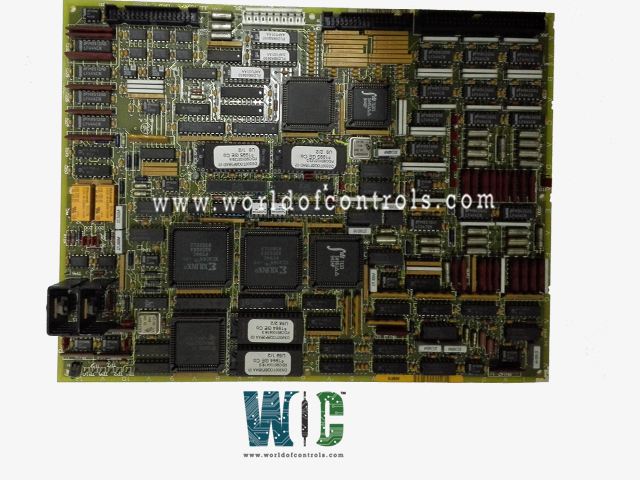SPECIFICATIONS
Part No.: DS200TCQBG2BCB
Manufacturer: General Electric
Country of Manufacture: United States of America (USA)
Product Type: Analog Expansion Module
Availability: In Stock
Series: Mark V
Functional Description
DS200TCQBG2BCB is an Analog Expansion Module developed by GE. It is a part of Mark V control system. It is specifically designed to handle the expansion of analog inputs and outputs in turbine control systems, providing the necessary functionality to support more complex and precise control over various system parameters.
Features
- Serves as an analog expansion module, enabling the system to integrate additional analog signals. This is essential for applications that require the monitoring and control of multiple parameters, such as temperature, pressure, speed, and flow rate, in complex turbine systems. Here are some of the primary features and functions of the TC2000 RST
- The primary function of this board is to expand the system’s ability to handle analog signals. This allows the Mark V control system to monitor and control a greater number of analog inputs and outputs, which is critical in ensuring precise control over turbine operations.
- The board is designed to condition analog signals, meaning it processes raw input signals to make them suitable for input into the Mark V control system. This includes tasks such as signal amplification, filtering, and scaling, ensuring the control system can accurately interpret the signals.
- The board ensures smooth communication between the various components of the Mark V control system and external devices or sensors by expanding the system's analog capacity. This allows more data to be transmitted and received without overloading the system’s base capacity.
- By increasing the number of available analog inputs and outputs, the TC2000 RST EXPAND ANALOG board enhances the ability of the control system to monitor system parameters more accurately, enabling more precise control and better operational performance.
Components
- Analog I/O Ports: The board features multiple input/output terminals for connecting analog devices or sensors, such as temperature sensors, pressure transducers, and flow meters.
- Signal Conditioning Circuits: The board includes active components like transistors, capacitors, and resistors to filter and condition the analog signals before they are fed into the control system for processing.
- Connectors: It has multiple connectors designed to accommodate the needs of the application. This includes female connectors, terminal strips, and possibly stabb-on connectors for easy integration with the system’s wiring.
- LED Indicators: The board is equipped with LED indicators that provide real-time status information. These LEDs help indicate operational status, fault conditions, or communication status, assisting operators and technicians in troubleshooting and maintaining the system.
- Reset and Diagnostic Buttons: Some versions of the board may include reset buttons and diagnostic features to troubleshoot system issues without needing to power down the entire control system.
Installation and Configuration
- Before installation, ensure that the control system is powered down, and all connections are properly isolated to prevent damage or electrical hazards.
- The TC2000 RST EXPAND ANALOG board is typically installed into a standard rack within the Mark V cabinet. The board is aligned with the corresponding slot and secured using screws in each corner.
- Once installed, the analog input/output terminals and connectors need to be carefully wired to the corresponding sensors or devices in the turbine system. This step is crucial for ensuring that all analog signals are properly routed to the board.
- The board may include jumpers or switches to configure specific operational parameters such as input/output range, signal types, or communication settings. It is important to review the system’s configuration manual and adjust these settings based on the application’s requirements.
- After installation, the system should be calibrated to ensure accurate measurement and control of the connected devices. This can involve adjusting the board’s settings to match the specifications of the sensors or systems it is controlling.
Maintenance and Troubleshooting
- Regularly inspect the board for any physical damage or signs of wear, such as burnt components, damaged connectors, or loose connections.
- Ensure the analog inputs and outputs are correctly calibrated to ensure accurate system readings. Miscalibrated sensors can lead to incorrect system behavior and performance degradation.
- Keep the board clean and free of dust or debris to avoid short-circuiting or component damage.
- Use the built-in diagnostic tools or LED indicators to troubleshoot and identify issues with the analog inputs or outputs. If the board is malfunctioning, it may require replacement or reconfiguration.
The WOC team is always available to help you with your Mark V requirements. For more information, please contact WOC.
Frequently Asked Questions
What is DS200TCQBG2BCB?
It is an Analog Expansion Module developed by GE under the Mark V series.
How does the board integrate with the control system?
The board integrates into the Mark VI control system by providing analog I/O channels, allowing the system to interface with external sensors and actuators. It ensures the smooth exchange of data and the management of analog signals for the operation of industrial equipment.
How does the board expand the system's capabilities?
By adding more analog I/O channels, the board expands the number of devices the system can monitor and control simultaneously, allowing for greater flexibility and scalability in large and complex systems.
